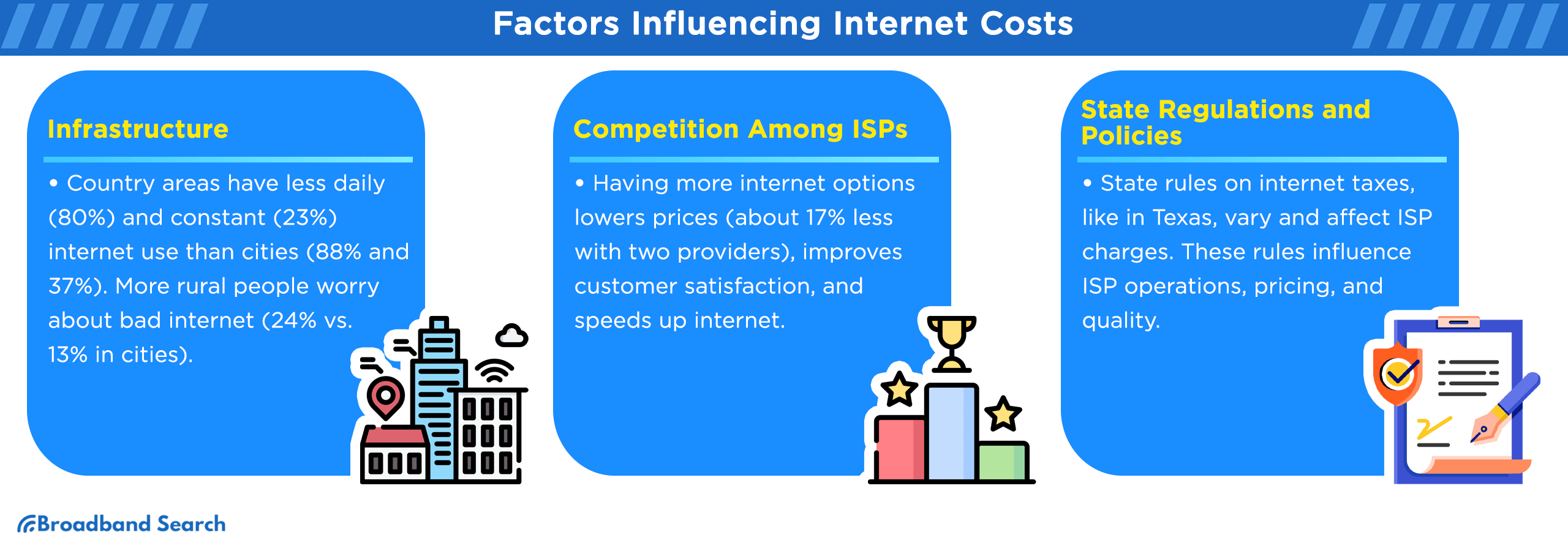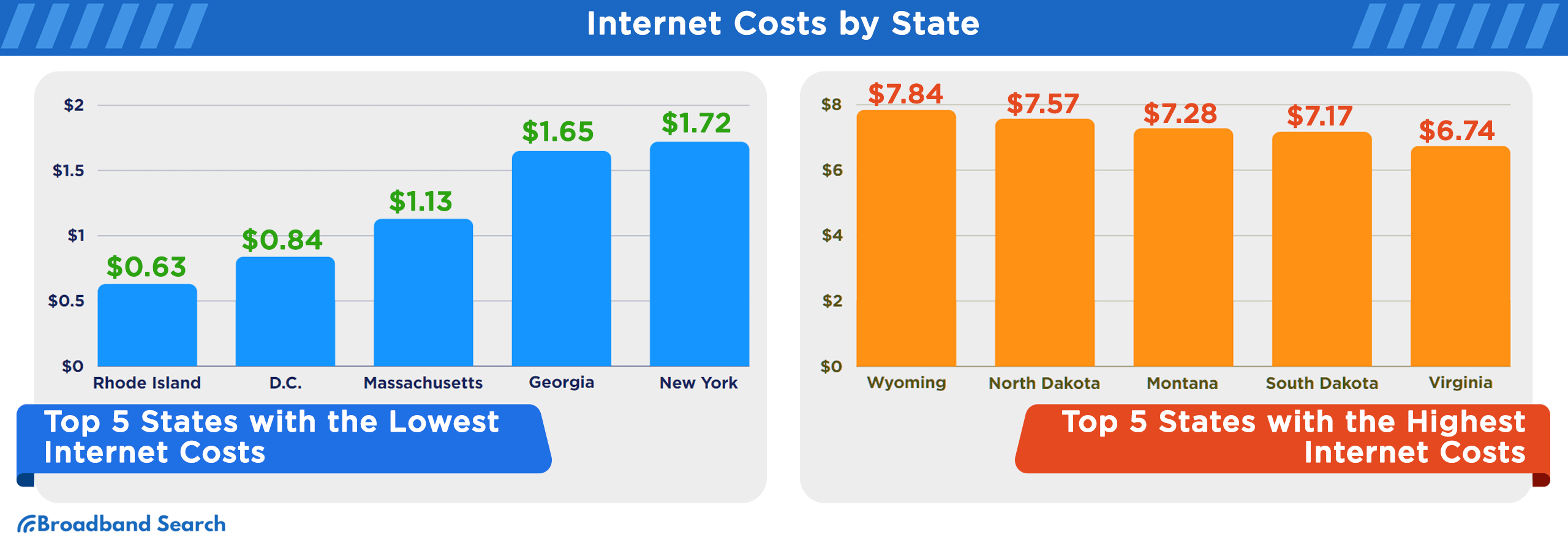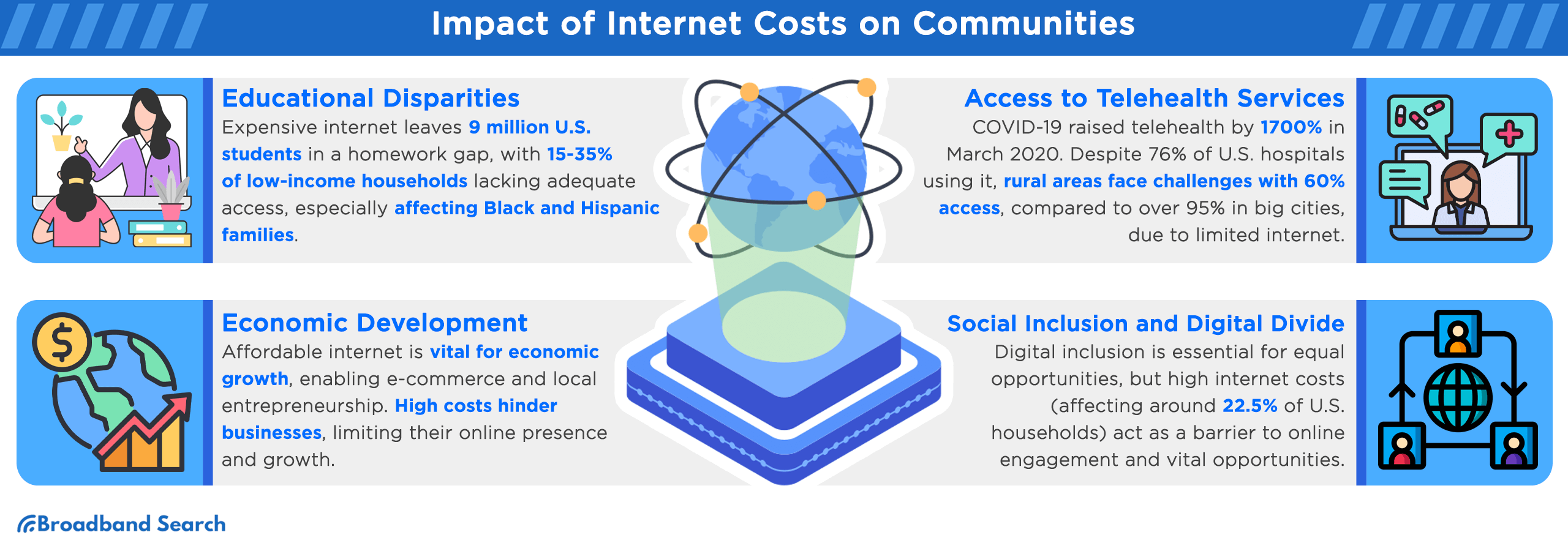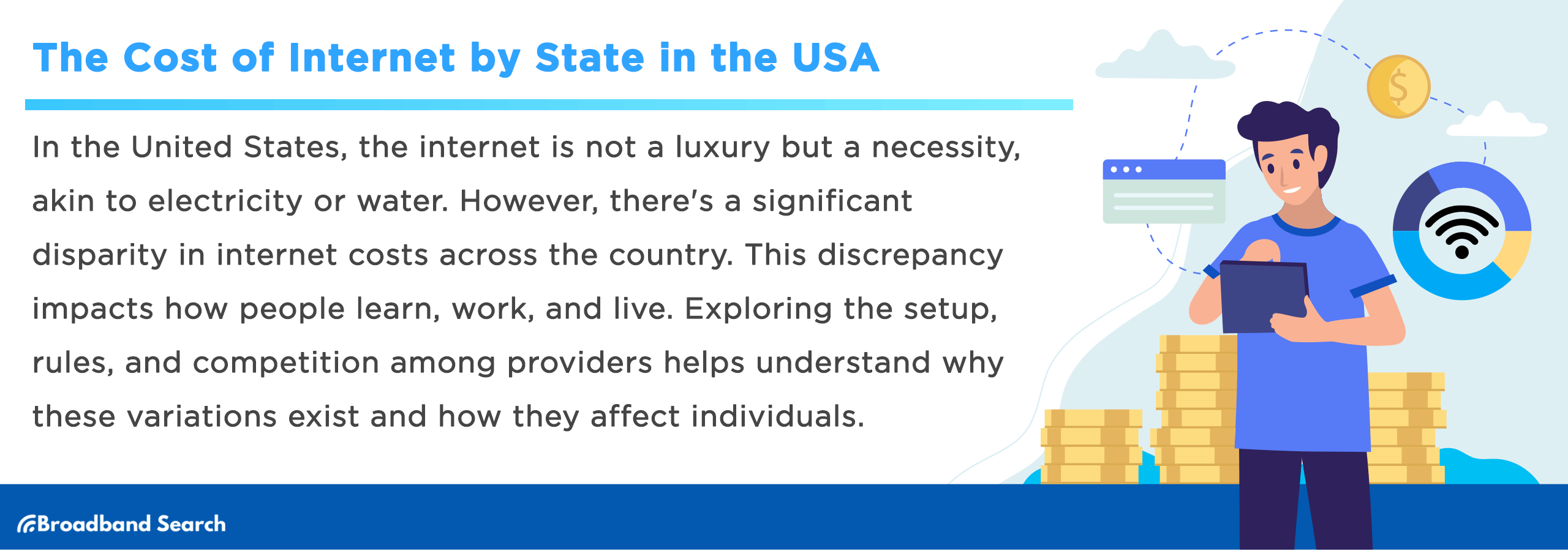In the United States, the internet isn't just a fancy extra—it's a must-have, like electricity or water. It's how we learn, find jobs, and keep up with the world. But there’s an issue: the cost of getting on the internet isn't the same everywhere you go in the country. Some places have it cheap; others, not so much. And this matters because it affects how people learn, work, and live.
Let’s dig into why Internet prices vary so much. How is the internet set up? What are the rules? What is the state of competition between providers? Then, let’s look at how those price differences affect folks.
Factors Influencing Internet Costs

A few key factors paint a clear picture of why some states pay more than others. By examining them, we can uncover the reasons behind the internet cost disparities across different states.
Infrastructure
The availability and cost of internet services can vary widely depending on whether you live in a city or the countryside:
- In rural areas, 80 percent of people use the Internet every day, compared to 88 percent in cities.
- Only 23 percent of rural residents are online all the time, while it's 37 percent in urban areas.
- People in the countryside often worry more about not having good internet. About 24 percent of them say it's a big problem. In cities, it's only 13 percent.
The "Last Mile" Challenge
Now, here's where it gets tricky. Imagine you're getting a package delivered to your house. The delivery person has to travel the last part from the main road to your doorstep. This is similar to the internet. The very last part that connects to your home can be super expensive.
This "last mile" makes up just 20 percent of the whole internet network but can cost 80% of the total bill. It's the most challenging part of the journey. And because of this, some people in the countryside might pay more for their internet and worry more about not having good service. The "last mile" is a big reason behind these differences in internet access and costs.
Connection Types
Fiber-optic
Fiber-optic internet is like having a super-fast sports car for your internet. It lets you do things online really quickly, like watching movies, downloading stuff, and playing games without any problems. But here's the catch - it can be a bit more expensive.
In some states, like Rhode Island, where they have lots of super-fast internet, the cost isn't too high. Rhode Island is number one in the whole country when it comes to how many people can get this speedy internet. On average, people there pay around $40 to $120 monthly. But in other places where it's not as easy to set up, it can cost more. So, whether you pay a lot or a little for fiber-optic internet can depend on where you live and how easy it is for them to install it.
DSL is like the trusty family car of internet connections. It might not be as fast as a sports car like fiber-optic, but it gets you where you need to go for most of your everyday online stuff. And the good part is, it usually doesn't cost as much as fiber-optic, which is great if you're trying to save some money.
Now, how much you pay for DSL can change depending on where you live. Take Oregon, for instance. In Oregon, there are more than 35 companies that provide high-speed internet for homes and businesses. DSL is the most popular kind of internet there, and folks pay around $55 a month on average for it. So, whether DSL is a good deal or not depends on where you live and how many companies offer it in your area.
Cable Internet is like the family car of internet connections – it's a balanced choice that offers decent speed without costing too much. It's a popular option in many households because it's not too slow and not too expensive.
The cost of cable internet can vary from state to state. Take Hawaii, for instance. There are about 10 companies in Hawaii that provide fast internet for homes and businesses. Cable internet is the most popular type there. People in Hawaii pay around $30 to $90 for it every month. So, whether you get a good deal on cable internet depends on where you live and how many companies offer it in your area.
Competition Among ISPs
Number of ISPs
Having more choices when picking your internet provider can be a good thing for your wallet. Internet prices tend to be higher when an area has just one provider. But when there are two or more options, the prices drop by around 17 percent.
People also seem happier with their internet when there's more competition. Customers report being more satisfied with their service when there are several providers. Plus, internet plans tend to be faster when there's more competition.
Municipal Broadband
When your local government gets involved in providing internet, it can drive prices down and provide an affordable alternative. Some cities, like Wadsworth, Ohio, have their internet service. They offer plans starting at just $25 a month for 20 Mbps and offer faster plans if needed (up to 500 Mbps).
This happens in other places, like Colorado, where cities do the same thing. When your city offers internet service, it creates more competition, which usually means lower prices.
State Regulations and Policies
Taxes and Fees
When it comes to taxes on internet access, they're usually linked to the fees you pay to your Internet Service Provider (ISP). But the twist is how these taxes work can be quite different depending on the state you're in. Some states treat them like regular sales taxes, while others see them as telecommunications taxes. And in some places, they don't tax them at all.
There are ten states, like Hawaii, New Hampshire, New Mexico, North Dakota, Ohio, South Dakota, Tennessee, Texas, Washington, and Wisconsin, that have special agreements allowing them to tax certain ISP charges. For instance, Texas currently imposes a tax on internet access charges exceeding $25 per month under this provision.
Regulatory Environment
State-level regulations can influence how ISPs operate within a state. Different states may have more or less stringent regulations, affecting internet service pricing and quality. In 2018, California passed its net neutrality law, the California Internet Consumer Protection and Net Neutrality Act of 2018. This law mandated that internet service providers (ISPs) treat all internet traffic equally, prohibiting practices like throttling or blocking specific websites or content.
ISPs operating in California had to adjust their practices to comply with the state's net neutrality law. This regulation prevented them from engaging in certain practices that could have led to the creation of internet "fast lanes" for some services. While this was intended to protect consumers and promote a level playing field, ISPs argued that compliance could increase their operational costs and potentially impact pricing (whether this would be true is debatable). State-level regulations can either complement or conflict with federal regulations, creating additional complexity in the industry.
Internet Costs by State

Data collected from 350,000 internet users across the U.S. was used to determine the average monthly internet prices in each state. To provide a more meaningful comparison, the average cost per Mbps (megabits per second) was calculated.
Top 5 States with the Lowest Internet Costs
- Rhode Island - $0.63
- D.C. - $0.84
- Massachusetts - $1.13
- Georgia - $1.65
- New York - $1.72
Factors contributing to lower costs
Competition among internet providers helps keep internet access costs down in these states.
Additionally, some states have rules and agreements that encourage affordable internet access. For instance, the California Advanced Services Fund (CASF) has played a significant role in promoting broadband deployment to underserved areas in California. Through CASF, the state has invested millions of dollars in supporting broadband infrastructure development, which has led to increased access and more competitive pricing in certain regions.
These states often invest in building the necessary infrastructure and work with private companies to make internet services more affordable for their residents. In Tennessee, an internet service provider (ISP) extended its network to previously underserved areas, which has helped maintain reasonable costs. This ISP has made substantial investments, totaling over $1.4 billion, in both wireless and wireline networks between 2018 and 2020.
Top 5 States with the Highest Internet Costs
- Wyoming - $7.84
- North Dakota - $7.57
- Montana - $7.28
- South Dakota - $7.17
- Virginia - $6.74
Factors contributing to higher costs
In states with higher internet costs, one of the main reasons is that there are fewer internet providers to choose from. These states also might have rules that make it harder for internet providers to compete, and this can lead to higher prices. For instance, in North Carolina, the General Assembly passed the "Level Playing Field Bill," which aims to protect private telecommunications companies by placing restrictions on local government investments in broadband infrastructure. This legislation limits the ways local governments can fund and develop broadband services
In certain states, additional costs like taxes and fees may apply. One notable illustration of this is AT&T's implementation of a State Cost Recovery Charge in Nevada, Ohio, and Texas. This charge varies depending on your specific location and is levied by AT&T to offset expenses related to state government taxes and required payments. It's important to clarify that these charges are not government-mandated taxes or surcharges, but fees collected by AT&T from its customers.
State Internet Cost Rankings
When it comes to the cost of monthly internet plans across different states, there's a wide range of prices. These costs can vary based on the type of internet connection you choose, such as DSL, fiber, or cable. Yahoo Finance has provided their own straightforward ranking of states, ordered from the lowest to the highest starting costs for monthly internet plans.
Regional Variations Within States
When we look at each state and try to look for trends, we can see some important differences.
First, it's usually easier to get excellent and affordable internet in cities and larger towns than in rural areas. Second, how much money people make in different parts of the state can also affect how much they pay for the internet. Lower-income areas might need help to afford internet services or people living there may have to settle for cheaper and lower-value plans.
Lastly, the local infrastructure (like the networks and cables) can also make prices go up or down.
So, why do these differences happen?
Sometimes, it's because of the land and how it's shaped. If an area has a lot of hills or is far from where the internet comes from, it can be more expensive to set up, which can mean higher costs for people living there. Mountain areas are often notorious for poor internet service.
Also, governments and companies might try to help out in some places more than others. They might spend more money to make the internet affordable in some areas but not as much in others. One reason for this is that areas with higher population densities tend to receive more attention and investment from governments and companies because there's a larger potential customer base.
In less populated or remote regions, the cost of building and maintaining internet infrastructure may outweigh the potential revenue, making it less attractive for private companies to invest. Local rules and laws can also make a difference, making it easier or harder to get affordable internet in certain places.
Impact of Internet Costs on Communities

Educational Disparities
Educational Accessibility
Internet costs impact students' ability to access online learning resources. In the United States, about nine million students still lack access to high-speed internet at home, creating a digital divide.
A study by the Pew Research Center found something called the "homework gap." It means that some kids don't have the internet they need to do their schoolwork at home. About 15 percent of households in the U.S. with school-age kids don't have good internet at home. But when we look at families with lower incomes (earning less than $30,000 a year), the problem gets worse. Around 35 percent of these families with kids between 6 and 17 years old don't have good internet at home. In contrast, only six percent of families earning $75,000 yearly face this issue.
This gap is especially big in Black and Hispanic families with school-age kids, especially those with low incomes.
Economic Development
Affordable internet drives economic growth, enabling e-commerce and local entrepreneurship. In 2022, Statista revealed that e-commerce sales in the U.S. exceeded $791 billion, illustrating the importance of online business. Local businesses with strong online presence often experience higher revenue growth, contributing to economic development within communities.
Barriers to Development
- Businesses without affordable internet access face barriers to reaching customers, managing operations, and competing effectively. High internet costs can limit their digital presence and growth potential.
- These barriers disproportionately affect smaller enterprises, hindering their ability to thrive in the digital age.
Access to Telehealth Services
According to the National Center of Biotechnology Information (NCBI), the COVID-19 pandemic led to a significant shift in healthcare practices. Due to safety concerns in traditional healthcare settings, many people turned to telehealth for their medical needs.
In March 2020, the Cleveland Clinic reported a staggering 60,000 telehealth visits, marking a remarkable 1700 percent increase compared to their usual monthly average. Similarly, from January to March 2020, there was a 154 percent increase in telehealth visits in the last week of March, with COVID-19-related issues making up 15.2 percent of these visits.
Right now, about 76 percent of hospitals in the United States use video and technology to connect with patients and doctors from far away. Yet here's the thing, the American Hospital Association (AHA) pointed out that in some rural places, not having good internet makes it hard for hospitals to use telehealth. So, even though many hospitals are trying to help patients through video, not everyone can benefit because of internet problems in some areas.
As a perfect example of the importance of universal telehealth access, in 2022, the Centers for Disease Control and Prevention (CDC) discovered that tobacco-related health issues affect people living in rural parts of America more than those in cities and larger towns. This happens due to factors like income, local culture, regulations, and limited access to healthcare.
One way to help individuals in rural areas quit smoking is through telehealth programs. These programs use the internet to provide support for quitting smoking. However, there's a challenge - telehealth works best with a good and fast internet connection. Unfortunately, in rural areas and tribal lands, only about 60 percent of people have access to such internet; in big cities, more than 95 percent do. Because of this internet gap, it's challenging to use telehealth effectively for tobacco control interventions in rural areas.
Social Inclusion and Digital Divide
Digital Inclusion
Digital inclusion is vital for societal participation and equal opportunities. It encompasses access to the internet, digital literacy, and the ability to engage in online activities. In a digital world, being digitally included is essential for accessing information, education, jobs, and services.
Internet Cost as a Barrier
Internet costs can be a big hurdle for many people. When internet prices are high, it can mean that some folks miss out on the chance to be part of online communities and access essential opportunities. To give you an idea, around 22.5% of all households in the U.S. don't have any internet at all. That's a massive 27.6 million homes without access.
The Bottom Line
Unequal internet costs have far-reaching consequences in the United States. At the heart of the differences in internet costs from state to state lies a complex interplay of factors. These factors, which include infrastructure, competition among internet service providers (ISPs), regulatory policies, and local economic conditions, significantly influence the price of internet access. State-specific circumstances have a profound impact on how much residents pay for their internet connection and the quality of service they receive.
One notable takeaway is that some states have succeeded in making the Internet more affordable for their residents. They have achieved this by fostering competition among ISPs, investing in network infrastructure, and implementing regulations that promote affordable access.
Conversely, other states grapple with higher internet costs due to limited competition, challenging geographical terrain, and policies that hinder accessibility. These disparities underscore the importance of addressing the digital divide on a state-by-state basis, ensuring that all Americans have access to reasonably priced, high-quality internet service, regardless of where they live. Bridging this digital divide is not just a goal; it's a crucial step toward a fairer, more connected, and inclusive society.
FAQ
How does affordable internet relate to economic growth?
Affordable internet is essential for economic growth, supporting e-commerce, entrepreneurship, and job opportunities. It enables businesses and individuals alike to thrive in the digital age.
Why is internet cost such a crucial issue in the United States?
Internet cost is crucial because it impacts education, economic opportunities, healthcare access, and social inclusion. High internet prices can create disparities, leaving many without essential online resources and opportunities.
Why is digital inclusion important?
Digital inclusion is vital for equal participation in society. It ensures everyone has access to information, education, jobs, and services in our increasingly digital world.
What can individuals do to help bridge the digital divide?
Individuals can advocate for affordable internet access, support community initiatives, and donate to organizations working to expand internet access in underserved areas.
How can businesses contribute to closing the internet cost gap?
Businesses can contribute to closing the internet cost app by advocating for affordable internet options, especially in rural areas, and supporting digital literacy programs to help people make the most of online opportunities.

